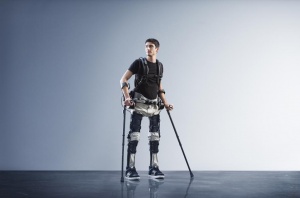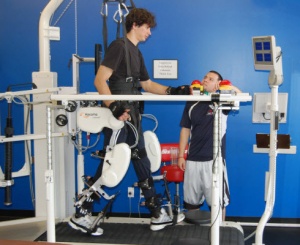Artificial Intelligence (AI) In Health Care and Rehabilitation
Original Editor - Lucinda hampton
Top Contributors - Lucinda hampton, Ines Musabyemariya and Angeliki Chorti
Introduction[edit | edit source]
Artificial Intelligence (AI) can be viewed as the fourth industrial revolution and the emerging frontier in medicine.[1] AI refers to the capability of a machine to perform a functional task overseen insightfully by humans. AI applies algorithms to learn, think, and then ultimately aide various clinical practices such as e.g. radiology and rehabilitation. AI is also used to find all relevant current information from journals, books, and evidence-based practice, helping in clinical decision-making in healthcare. Moreover, AI technologies aides in the reduction of medical errors in health care practices.[2]
The use of AI technologies is swiftly growing in health care and rehabilitation. As health professionals, we need to increase our awareness AI's applications in rehabilitation to provide best practice patient care.[2]
Sport Medicine/ Orthopedics[edit | edit source]
Current studies looking at the use of AI in the areas of orthopedic surgery and sports medicine show promise in predicting athlete injury risk, the interpretation of medical imaging, evaluating patient-reported outcomes etc. However as with all new knowledge this emerging technology will require a elemental working comprehension of the strengths, limitations, and applications of AI-based tools.[2]
Rehabilitation[edit | edit source]
AI in rehabilitation can augment the patient care by aiding physical therapists in several ways eg providing a thorough assessment, forecasting patients’ performance, establishing a diagnosis. AI in medical and rehabilitation practices can also be applied to problem solving, x-ray diagnosis and protocols for best practice.[2]
Neurology[edit | edit source]
Computer-aided diagnosis (CAD) systems using AI and modern signal processing methods have the ability to help clinicians in analyzing and interpreting physiological signals and images more effectively in Neurological Disorders eg epilepsy, Parkinson's disease, Alzheimer's disease, multiple sclerosis, and ischemic brain stroke.[3]
Brain disorders: The use of AI techniques is helping solve a large number of clinical problems dealing with the brain. Recent research and relevant data accumulation are actively developing an increasingly number of effective algorithms, aiding in our understanding of complex brain mechanism.[4]
AI has vast potential in neurologic physical therapy. AI is being developing that can eg. be used in robotic-assisted therapy; assess motor function and gait, assess clients level of function, upper extremity recovery, and movement. Examples are eg using data from wearable sensors to spot gait patterns (abnormal gait patterns, gait asymmetry etc). AI sensors recognises abnormal movement patterns during functional movements and can be of great value in analysis of functional tasks, and prescription of personalized treatment plans. In concert with telerehabilitation, virtual reality, and body-worn sensors in the future this may be a fantastic way to monitor the type and dosage of home exercises. eg alerts to a remote therapist could be alerted when a patient is performing exercises incorrectly or when there is a need to modify exercises.[5]
AI and Assistive Technology[edit | edit source]
AI Challenges[edit | edit source]
In the future as a profession, we must learn to embrace these changes and know how to best use AI. Rather than learn more advanced manual therapy skills, or improving our diagnostic skills, we may find that to succeed as a profession we need to be able to analysis and interpret AI generated algorithms, apply judgement to them and integrate this AI into our practice eg ethical, professional and social contexts. If we fail to join the conversation around AI and incorporate it in practice, we run the risk that our decision-making will be left to machine intelligence, and not simply informed by it. We must bring humans and AI together to better our outcomes.[6]
AI Literacy among Rehabilitation Professionals[edit | edit source]
AI literacy is a crucial skill for rehabilitation professionals and students, as it enables them to understand and use artificial intelligence (AI) technologies effectively[7]. The field of rehabilitation is continually evolving due to the increasing demand for rehabilitation services worldwide. Where AI is globally used by assisting in the evaluation of neurological function and recovery progress for stroke patients, providing personalized feedback for rehabilitation exercises, increasing accessibility through virtual reality and telerehabilitation, and enhancing the efficiency of diagnosis and treatment for doctors and therapists, rehabilitation professionals are bridging the gaps in the field. AI literacy among rehabilitation professionals will enables professionals to critically evaluate online health information, helping combat the infodemic surrounding rehabilitation topics[7].
Misconception about the Use of AI in Rehabilitation Practice[edit | edit source]
There are some misunderstandings about the use of AI in rehabilitation practice[8].
- Some people believe that AI will replace human therapists, which could harm the quality of care for patients. However, this is not true. AI is a tool that helps therapists provide personalized feedback, monitor patient progress, and make interventions more effective.
- Additionally, some assume that implementing AI is too complicated and expensive for rehabilitation settings. However, with technological advancements, AI is becoming more accessible, affordable, and easier to integrate into existing systems.
- AI is not Reliable: This is not true, as AI systems are designed and evaluated with rigorous methods and standards, involving multiple stakeholders and ethical considerations. nevertheless, it is also important to note that AI requires more rigorous evaluation processes, ethical considerations, continuous research and development, and stakeholder involvement to ensure responsible AI integration.[9].
- AI systems are also transparent and explainable, meaning that they can provide reasons and evidence for their decisions and actions.
Situation in Low- and Middle-Income Countries[edit | edit source]
Artificial intelligence (AI) is rapidly emerging as a transformative technology in the healthcare industry, particularly in low- and middle-income countries (LMICs). With its potential to address the persistent challenges of inadequate human resources, limited access to quality healthcare systems, and communicable diseases, AI is being leveraged for diverse applications including diagnosis, disease control, patient feedback, and health system strengthening. The integration of AI in LMICs is expected to have a significant impact on healthcare delivery and health outcomes, thereby contributing to the global agenda of achieving universal health coverage[10][11].
In addition to disease diagnosis and outbreak prediction, AI also shows great rehabilitation potential in low- and middle-income countries (LMICs). AI-powered rehabilitation tools are being developed to help patients recover from injuries, illnesses, and disabilities[12]. These tools are especially helpful in areas with a shortage of healthcare professionals and limited access to rehabilitation facilities[13]. AI-powered rehabilitation tools include virtual reality systems, wearable devices, and mobile apps that help patients perform exercises and track their progress. This can improve patient outcomes, reduce healthcare costs, and increase access to quality rehabilitation services in LMICs.
Resources[edit | edit source]
Ethics and governance of artificial intelligence for health: guidance on large multi-modal models available at link below:
References[edit | edit source]
- ↑ Ramkumar PN, Luu BC, Haeberle HS, Karnuta JM, Nwachukwu BU, Williams RJ. Sports medicine and artificial intelligence: a primer. The American Journal of Sports Medicine. 2022 Mar;50(4):1166-74.Available:https://pubmed.ncbi.nlm.nih.gov/33900125/ (accessed 4.1.2024)
- ↑ 2.0 2.1 2.2 2.3 Alsobhi M, Khan F, Chevidikunnan MF, Basuodan R, Shawli L, Neamatallah Z. Physical Therapists’ Knowledge and Attitudes Regarding Artificial Intelligence Applications in Health Care and Rehabilitation: Cross-sectional Study. Journal of Medical Internet Research. 2022 Oct 20;24(10):e39565.Available:https://www.ncbi.nlm.nih.gov/pmc/articles/PMC9634519/ (accessed 4.1.2024)
- ↑ Raghavendra U, Acharya UR, Adeli H. Artificial intelligence techniques for automated diagnosis of neurological disorders. European neurology. 2020 Nov 19;82(1-3):41-64.Available: https://pubmed.ncbi.nlm.nih.gov/31743905/(accessed 4.1.2024)
- ↑ Segato A, Marzullo A, Calimeri F, De Momi E. Artificial intelligence for brain diseases: A systematic review. APL bioengineering. 2020 Dec 1;4(4).Available:https://www.ncbi.nlm.nih.gov/pmc/articles/PMC7556883/ (accessed 4.1.2024)
- ↑ Fulk G. Artificial Intelligence and Neurologic Physical Therapy. Journal of Neurologic Physical Therapy. 2023 Jan 1;47(1):1-2.Available:https://doaj.org/article/c7404c4f7fa0437db10c82a4a17524f0 (accessed 4.1.2024)
- ↑ Rowe M, Nicholls DA, Shaw J. How to replace a physiotherapist: artificial intelligence and the redistribution of expertise. Physiotherapy Theory and Practice. 2022 Nov 18;38(13):2275-83. Available:https://pubmed.ncbi.nlm.nih.gov/34081573/ (accessed 4.1.2024)
- ↑ 7.0 7.1 Khalil Kimiafar, Masoumeh Sarbaz, Seyyed Mohammad Tabatabaei, Kosar Ghaddaripouri, Mousavi A, Marziyeh Raei Mehneh, et al. Artificial Intelligence Literacy Among Healthcare Professionals and Students: A Systematic Review. Frontiers in health informatics. 2023 Nov 11;12:168–8.
- ↑ Artificial Intelligence in Medicine and Physical Therapy. www.fsbpt.org.
- ↑ Davids J, Niklas Lidströmer, Hutan Ashrafian. Artificial Intelligence for Physiotherapy and Rehabilitation. Springer eBooks. 2021 Jan 1;1–19.
- ↑ Alami H, Rivard L, Lehoux P, Hoffman SJ, Cadeddu SBM, Savoldelli M, et al. Artificial intelligence in health care: laying the Foundation for Responsible, sustainable, and inclusive innovation in low- and middle-income countries. Globalization and Health. 2020 Jun 24;16(1).
- ↑ Sumner J, Lim HW, Chong LS, Bundele A, Mukhopadhyay A, Kayambu G. Artificial intelligence in physical rehabilitation: A systematic review. Artificial Intelligence in Medicine. 2023 Dec 1;146:102693.
- ↑ Unlocking digital healthcare in lower- and middle-income countries | McKinsey. www.mckinsey.com.
- ↑ Bright T, Wallace S, Kuper H. A Systematic Review of Access to Rehabilitation for People with Disabilities in Low- and Middle-Income Countries. International Journal of Environmental Research and Public Health. 2018 Oct 2;15(10):2165.








